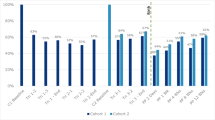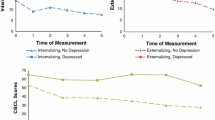Objectives: Longitudinal studies of maternal depression in the postpartum period have demonstrated that a chronic state of depressive symptoms is not rare. In spite of this, however, the characteristics of chronically depressed mothers have rarely been studied. This study examines the demographic and socioenvironmental characteristics across time of childrearing women with chronic depressive symptoms. Methods: A cohort of 476 childrearing lower-income mothers was interviewed from the first trimester of pregnancy through the tenth year postpartum. The Center for Epidemiologic Studies-Depression Scale (CES-D; Radloff, L. (1977) Appl Psychol Meas 1:385–401) was used to define depressive symptomatology. Four groups were defined based on the CES-D scores at 18 months, 3, 6 and 10 years: never-depressed (CES-D < 16), depressed only at one phase (CES-D ≥ 16), chronically mildly depressed (CES-D > 16 and ≤24 at three or more phases), and chronically severely depressed (CES-D ≥ 25 at three or more times). Demographic and socioenvironmental characteristics of the groups were evaluated across time. Results: Chronically depressed women compared to never-depressed women were less likely to be married, had less education, had lower family income, and were more likely to use substances. They reported more frequent arguments with close family members or friends, separation/divorce with partners, financial problems, less social support, and more financial strain. Conclusions: Women who continue to be depressed across the 10 postpartum years have less optimal outcomes compared to women who are not depressed and those who are only intermittently depressed. Pregnancy and delivery and subsequent pediatric visits are important times to identify women who are depressed.
Similar content being viewed by others
REFERENCES
Gelfand DM, Teti DM. The effects of maternal depression on children. Clin Psychol Rev 1990;10:329–53.
Coleman EZ, Ghodsian M, Wolkind SN. Depression in mothers 6 years after the birth of a first child. Soc Psychiatry 1986;21:76–82.
Philipps LHC, O'Hara MW. Prospective study of postpartum depression: 4 1/2-Year follow-up of women and children. J Abnorm Psychol 1991;100(2):151–5.
Alpern L, Lyons-Ruth K. Preschool children at social risk: Chronicity and timing of maternal depressive symptoms and child behavior problems at school and at home. Dev Psychopathol 1993;5:371–87.
Cooper P, Murray L. Course and recurrence of postnatal depression. Br J Psychiatry 1995;166:191–5.
Campbell SB, Cohn JF. The timing and chronicity of postpartum depression: Implications for infant development. In: Murray L, Cooper PJ, editors. Postpartum depression and child development. New York: Guilford Press, 1997:165– 97.
Najman JM, Anderson MJ, Bor W, O'Callaghan MJ, Williams GM. Postnatal depression – myth and reality: Maternal depression before and after the birth of a child. Soc Psychiatry Psychiatr Epidemiol 2000;35:19–27.
Brennan PA, Hammen C, Andersen MJ, Bor W, Najman JM, Williams GM. Chronicity, severity, and timing of maternal depressive symptoms: Relationships with child outcomes at age 5. Dev Psychol 2000;36(6):759–66.
McLennan JD, Kotelchuck M, Cho H. Prevalence, persistence, and correlates of depressive symptoms in a national sample of mothers of toddlers. J Am Acad Child Adolesc Psychiatry 2001;40(11):1316–23.
Bromet EJ, Solomon ZH, Dunn LO, Nicklas NN. Affective disorder in mothers of young children. Br J Psychiatry 1982;140:30–6.
Campbell SB, Cohn JF, Myers TA. Depression in first-time mothers: Mother infant interaction and depression chronicity. Dev Psychol 1995;31:349–57.
Teti DM, Gelfand DM, Messinger DS, Isabella R. Maternal depression and the quality of early attachment: An examination of infants, preschoolers, and their mothers. Dev Psychol 1995;31:364–76.
Frankel KA, Harmon RJ. Depressed mothers: They don't always look as bad as they feel. J Am Acad Child Adolesc Psychiatry 1996;35:289–98.
NICHD, Early Child, Care Research, Network. Chronicity of maternal depressive symptoms, maternal sensitivity, and child functioning at 36 months. Dev Psychol 1999;35(5):1297–1310.
Brown GW, Bhrolchain MN, Harris T. Social class and psychiatric disturbance among women in an urban population. Sociology 1975;9:225–54.
Hall LA, Williams CA, Greenberg RS. Supports, stressors, and depressive symptoms in low-income mothers of young children. Am J Public Health 1985;75(5):518–22.
Belle D. Poverty and women's health. Am Psychol 1990;45(3):385–9.
Boyce P, Harris M, Silove D, Morgan A, Wilhelm K, Hadzi-Pavlovic D. Psychological factors associated with depression: A study of socially disadvantaged women with young children. J Nerv Ment Dis 1998;186(1):3–11.
Romito P, Saurel-Cubizolles M-J, Lelong N. What makes new mothers unhappy: Psychological distress one year after birth in Italy and France. Soc Sci Med 1999;49:1651–61.
Richman N. Behavioral problems in pre-school children: Family and social factors. Br J Psychiatry 1977;131:523–7.
Lang C, Field T, Pickens J, Martinez A, Bendell D, Yando R, Routh D. Preschoolers of dysphoric mothers. J Child Psychol Psychiatry 1996;37(2):221–4.
D'Arcy C, Siddique CM. Social support and mental health among mothers of preschool and school age children. Soc Psychiatry 1984;19:155–62.
Hall LA, Farel AM. Maternal stresses and depressive symptoms: Correlates of behavior problems in young children. Nurs Res 1988;37(3):156–61.
Reis J. Correlates of depression according to maternal age. J Genet Psychol 1988;149:535–45.
Costello CG. Social factors associated with depression: A retrospective community study. Psychol Med 1982;12:329– 39.
Webster-Stratton C, Hammond M. Maternal depression and its relationship to life stress, perceptions of child behavior problems, parenting behaviors, and child conduct problems. J Abnorm Child Psychol 1988;16(3):299–315.
Schuckit MA. Drug and alcohol abuse: A clinical guide to diagnosis and treatment (4th edn.) New York: Plenum, 1995.
Day NL, Richardson GA, Geva D, Robles N. Alcohol, marijuana, and tobacco: Effects of prenatal exposure on offspring growth and morphology at age six. Alcohol Clin Exp Res 1994;18(4):786–94.
Radloff L. The CES-D Scale: A self-report depression scale for research in the general population. Appl Psychol Meas 1977;1:385–401.
Myers JK, Weissman MM. Use of a self-report symptom scale to detect depression in a community sample. Am J Psychiatry 1980;137(9):1081–4.
Breslau N. Depressive symptoms, major depression, and generalized anxiety: A comparison of self-reports on CES-D and results from diagnostic interviews. Psychiatry Res 1984;15:219–29.
Comstock GW, Helsing KJ. Symptoms of depression in two communities. Psychol Med 1976;6:551–64.
Weissman MM, Sholomskas D, Pottenger M, Prusoff BA, Locke BZ. Assessing depressive symptoms in five psychiatric populations: A validation study. Am J Epidemiol 1977;106(3):203–14.
Burns EI, Doremus PC, Potter MB. Value of health, incidence of depression, and level of self-esteem in low-income mothers of pre-school children. Issues Compr Pediatr Nurs 1990; 13(2):141–53.
Burdette HL, Whitaker RC, Harvey-Berino J, Kahn RS. Depressive symptoms in low-income mothers and emotional and social functioning in their preschool children. Ambul Pediatr 2003;3(6):288–294.
Murphy JM, Olivier DC, Monson RR, Sobol AM, Federman EB, Leighton AH. Depression and anxiety in relation to social status. Arc Gen Psychiatry 1991;48:223–9.
ACKNOWLEDGMENT
The authors wish to thank Young Jhon for her assistance with data analyses.
Author information
Authors and Affiliations
Corresponding author
Rights and permissions
About this article
Cite this article
Seto, M., Cornelius, M.D., Goldschmidt, L. et al. Long-Term Effects of Chronic Depressive Symptoms Among Low-Income Childrearing Mothers. Matern Child Health J 9, 263–271 (2005). https://doi.org/10.1007/s10995-005-0002-x
Published:
Issue Date:
DOI: https://doi.org/10.1007/s10995-005-0002-x




